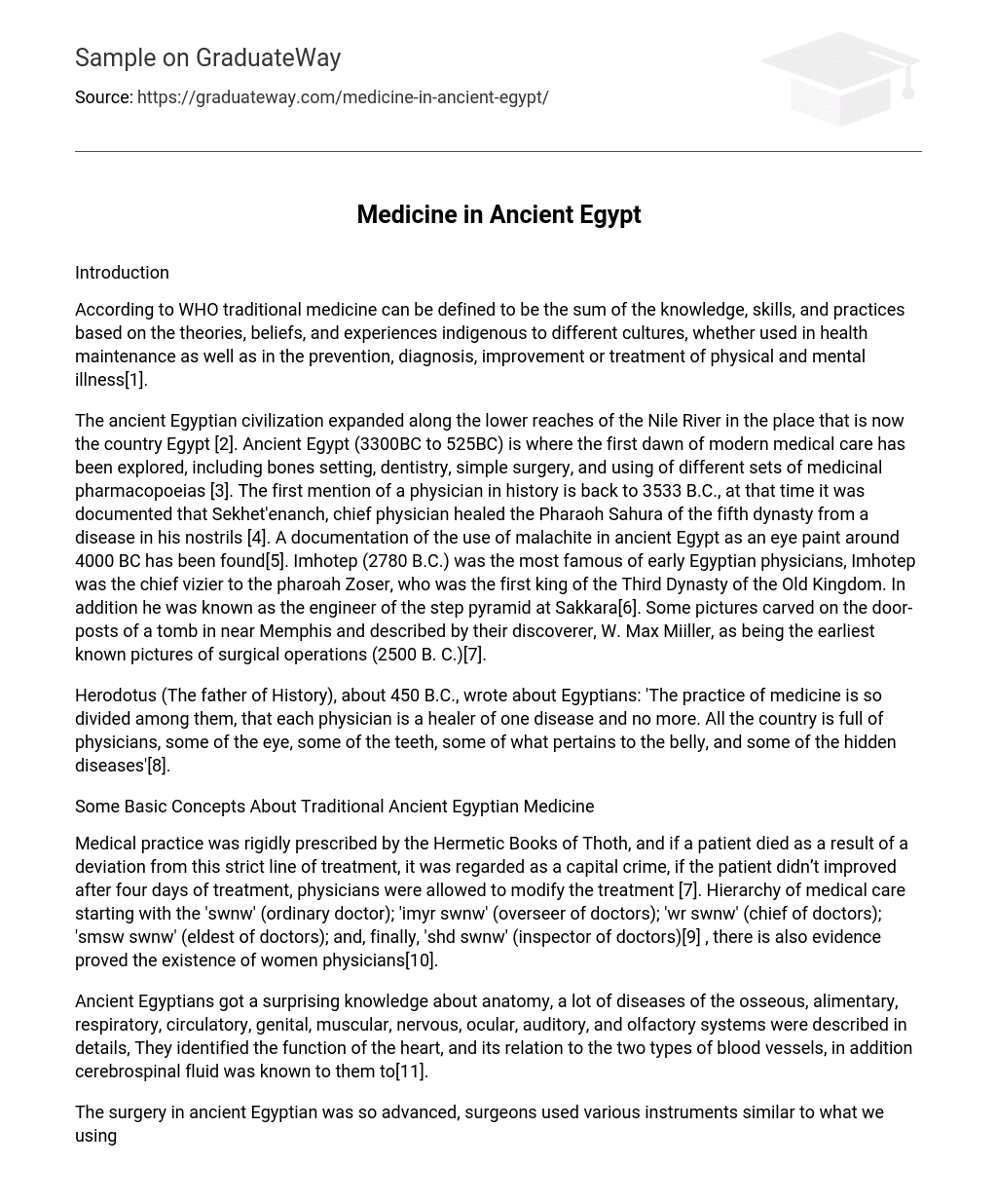Introduction
According to WHO traditional medicine can be defined to be the sum of the knowledge, skills, and practices based on the theories, beliefs, and experiences indigenous to different cultures, whether used in health maintenance as well as in the prevention, diagnosis, improvement or treatment of physical and mental illness[1].
The ancient Egyptian civilization expanded along the lower reaches of the Nile River in the place that is now the country Egypt [2]. Ancient Egypt (3300BC to 525BC) is where the first dawn of modern medical care has been explored, including bones setting, dentistry, simple surgery, and using of different sets of medicinal pharmacopoeias [3]. The first mention of a physician in history is back to 3533 B.C., at that time it was documented that Sekhet’enanch, chief physician healed the Pharaoh Sahura of the fifth dynasty from a disease in his nostrils [4]. A documentation of the use of malachite in ancient Egypt as an eye paint around 4000 BC has been found[5]. Imhotep (2780 B.C.) was the most famous of early Egyptian physicians, Imhotep was the chief vizier to the pharoah Zoser, who was the first king of the Third Dynasty of the Old Kingdom. In addition he was known as the engineer of the step pyramid at Sakkara[6]. Some pictures carved on the door-posts of a tomb in near Memphis and described by their discoverer, W. Max Miiller, as being the earliest known pictures of surgical operations (2500 B. C.)[7].
Herodotus (The father of History), about 450 B.C., wrote about Egyptians: ‘The practice of medicine is so divided among them, that each physician is a healer of one disease and no more. All the country is full of physicians, some of the eye, some of the teeth, some of what pertains to the belly, and some of the hidden diseases'[8].
Some Basic Concepts About Traditional Ancient Egyptian Medicine
Medical practice was rigidly prescribed by the Hermetic Books of Thoth, and if a patient died as a result of a deviation from this strict line of treatment, it was regarded as a capital crime, if the patient didn’t improved after four days of treatment, physicians were allowed to modify the treatment [7]. Hierarchy of medical care starting with the ‘swnw’ (ordinary doctor); ‘imyr swnw’ (overseer of doctors); ‘wr swnw’ (chief of doctors); ‘smsw swnw’ (eldest of doctors); and, finally, ‘shd swnw’ (inspector of doctors)[9] , there is also evidence proved the existence of women physicians[10].
Ancient Egyptians got a surprising knowledge about anatomy, a lot of diseases of the osseous, alimentary, respiratory, circulatory, genital, muscular, nervous, ocular, auditory, and olfactory systems were described in details, They identified the function of the heart, and its relation to the two types of blood vessels, in addition cerebrospinal fluid was known to them to[11].
The surgery in ancient Egyptian was so advanced, surgeons used various instruments similar to what we using today such as the scalpel, forceps, and scissors, splints were made of reeds tied together by strips of linen or of pieces of wood padded with plant fibres [12]. They sutured wounds, stopped bleeding using cautery[12]. Boils, abscesses, and septic wounds were opened surgically and drained by pieces of linen, and poultices were used as well [13]. A dislocated shoulder was reduced in a similar way to the Kocher method, also a dislocated mandible reduced by the method used today [14]. The plaster used for fractures consisted of linen soaked in a sticky material which hardened, They made circumcision a lot and there are some reports documented a surgical treatment of hernia [12].
They had some knowledge of psychology, Diodorus reported that it was written over the library of the Ramesseum ‘Healing Place of the Soul ‘. The patient suggested to write his troubles in a letter to dead relatives (catharsis), also there were some specialists in dream interpretation[11]
The routes of drug administration as mentioned in medical papyri were basically five; oral, rectal, vaginal, topical, and fumigation, treatments were given in different forms like; pills, cakes, ointments, eye drops, gargles, suppositories, fumigations, and baths[15].
Ancient Egyptian Medical Papyri
Pharaohs documented day after day events using hieroglyphic language by carving on walls of temples, stones, clay or papyri[16]. The translation of the Rosetta stone in 1822, allowed the translation of ancient Egyptian hieroglyphic inscriptions and papyri, including many Egyptian medical papyri[17].
The language which was used for writing on papyri is mostly a cursive script known as hieratic. This was written from right to left, with red ink for the headings and black ink for the bulk of the material. Papyrus was made by interweaving split river-reeds (Cyperus papyrus), pounding under water, drying to form coarse brownish sheets then being written with brush and ink, and finally glued together at the edges, to make a roll[16].
Most of our knowledge about ancient Egyptian traditional medicine was originated from the ancient Egyptian medical papyri includes Ebers papyrus, Edwin Smith papyrus, Kahun Papyrus, Ramesseum medical papyri, Hearst papyrus, London Medical Papyrus, Brugsch Papyrus, Carlsberg papyrus, Chester Beatty Medical Papyrus, Brooklyn Papyrus, Erman Papyrus and Leiden Papyrus.
There are many papyri studied medicine and treatment in ancient Egypt, but most of our knowledge was derived from eight papyri which known as the Kahun, the Edwin Smith, the Ebers, the Hearst, the Erman, the London, the Berlin, and the Chester Beatty.





